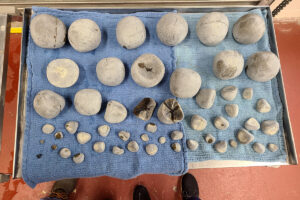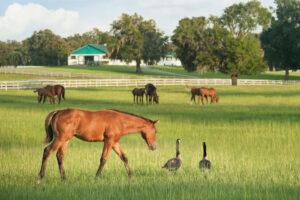Herpesvirus Type 1 Hits Hard
Ohio and Pennsylvania have confirmed or reported cases of the neurologic form of equine herpesvirus type 1 (EHV-1, see Pennsylvania information on page 15). But the worst problems reported thus far have occurred in Ohio, where 12 horses died in an outbreak at the University of Findlay (see article #4127 at www.TheHorse.com) and three other Ohio horses die
- Topics: Article
Ohio and Pennsylvania have confirmed or reported cases of the neurologic form of equine herpesvirus type 1 (EHV-1, see Pennsylvania information on page 15). But the worst problems reported thus far have occurred in Ohio, where 12 horses died in an outbreak at the University of Findlay (see article #4127 at www.TheHorse.com) and three other Ohio horses died from exposure to those initial cases. Tests are being done to compare the Ohio virus to isolates from past EHV-1 outbreaks to determine if the Ohio virus is especially virulent. The virus is thought to have spread from Findlay horses being treated at The Ohio State University (OSU) to other horses being treated there from Jan. 18-Feb. 11.
The EHV-1 organism can cause three different forms of disease, including rhinopneumonitis (a respiratory disease often affecting young horses), abortions in pregnant mares, and neurologic disease. Horses in the Ohio and Pennsylvania outbreaks have shown fevers, respiratory illness, and neurologic deficits. There are at least seven other strains of equine herpesviruses. Horses can survive the neurologic form of EHV-1 with supportive care, but if a horse becomes recumbent (stays down), it is difficult to nurse the horse back to health. The virus doesn’t live long in the environment, and it can be killed with bleach.
EHV-1 swept through the University of Findlay’s English riding facility beginning Jan. 12, infecting 90% of the 138 horses. Five of the Findlay horses with profound neurologic signs were treated at Ohio State’s veterinary teaching hospital between Jan. 19-28. Steve Reed, DVM, Dipl. ACVIM, head of equine medicine and surgery at OSU said, “Initially the animals were not able to be totally segregated from other horses; however, within a few days of arrival, horses with EHV1 were segregated in the veterinary teaching hospital. After January 20th, all horses from the University of Findlay were maintained in a separate aisle within the hospital. In all horses isolation protocol was utilized.”
The virus is not generally thought to be contagious after horses reach the neurologic stage of disease, so officials were surprised when, despite isolation protocol, horses unrelated to the outbreak began showing symptoms at the hospital and after discharge. Reed said, “We worked on the premise that they weren’t contagious. (Research) says that they’re usually not as likely to be viremic (at the neurologic stage of illness). They’re most contagious when they have the fever and respiratory signs, early on…the virus load is so much lower at that time (during the neurologic stage), and (virus cells are) not still in the respiratory and nasal mucosa, and are not likely to spread. If it’s setting inside some endothelial cells in the nervous system, it’s not very likely to be contagious to another horse
Create a free account with TheHorse.com to view this content.
TheHorse.com is home to thousands of free articles about horse health care. In order to access some of our exclusive free content, you must be signed into TheHorse.com.
Start your free account today!
Already have an account?
and continue reading.

Related Articles
Stay on top of the most recent Horse Health news with

















